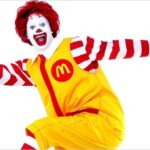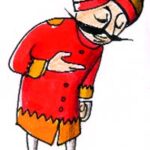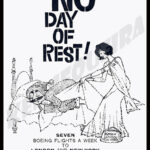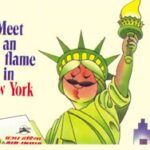Avatars: How Mascots Help Brands Engage Better
 We have all as marketers discussed, debated, worked on creating, shaping, modifying the brands that we have managed. Often the central point of conversation would have been about the brand character, its personality. We would either have brand bibles that gave a pen picture of the brand or at times written one de novo.
We have all as marketers discussed, debated, worked on creating, shaping, modifying the brands that we have managed. Often the central point of conversation would have been about the brand character, its personality. We would either have brand bibles that gave a pen picture of the brand or at times written one de novo.What these pen pictures do is that they make the brand tangible for us. As marketers we have given several dimensions such as names, personalities, characteristics some have also given their brands a face!
Mascots for brands have been around for as long as we have known brands. Brands with mascots achieve a lot with very little. It takes most brands time and effort in the form of consistent communication to establish the character traits and a personality for themselves. Of course along with a Hail Mary for it to be understood by the consumers the way it is intended.
Today more than ever before, in an era of increasing choices and decreasing attention spans mascots can play a very significant role in carving consumer mind-space for brands. The digital natives of today understand and also identify with the concept of “avatars”. The digital natives understand that though not the actual person, the avatars are perhaps the nearest likelihood or the self-projection.
From a brands perspective it allows consumers to interact with a “face” or a “person” instead of some nameless, faceless representative. It adds that little bit of familiarity which is key for brand comfort.
Mascots help the brand engage better with its consumers
- They can be de facto brand spokespersons. Mascots can have real time presence in sociosphere, sharing, commenting, reacting and interacting with consumers all across.
- Mascots are more flexible than other brand assets and identifiers such as logos, colors and fonts. They can speak different languages, dress for the occasion helping brands localize and customize messages. Take on multiple avatars!
- The mascot can be a brands promoter at the point of sale. Driving recall, reinforcing the brands core values and even delivering a sales pitch.
- Brand ambassadors may switch or cease to be relevant but mascots will always belong to the brand.
- The sheen of the brand may diminish over time but mascots are ageless. Sometimes even out surviving the brand.
Mascots needn’t necessarily be cartoons, caricatures or animated characters alone. They can be and are human too. Many brands have successfully created characters and used them in communication across multiple touch points.
Here are a few brands and their mascots that according to me have served or are serving their brands superlatively across TV commercials, radio spots, print ads, hoardings and web films.
Look forward to your thoughts.
Lost In Translation: Do Unrelated Brand Extensions Erode Brand Value In The Long Term?
Its election time in India. Starting April 07, the world’s biggest democracy shall go in for a marathon round of voting that would be spread over a month. The election jamboree has several contestants and in the fray are people from different walks of life. The noteworthy ones though are the contestants who have been in the public consciousness but for totally different reasons. If celebrities be considered individuals who are brands that they are courtesy their achievements/fame in their original profession. Their foray into politics therefore, is akin to a brand extension.
Now as marketers we are familiar with extensions and have seen many such examples. It is the author’s humble opinion that brand extensions into un-related categories are detrimental to the brand. Now I do not have empirical evidence to back this but more often than not, the brand attributes that made the brand successful in its space would not resonate with consumers in an un-related space. Yes there have been brave attempts at looking at a core set of values and carrying forward those elements that are relevant to the spaces related or otherwise that the brand is being carried into.
Since there is a constant back and forth amongst marketers regarding brands as people and people as brands (also the starting point of the current discussion), it would only be fair to look at things through Kapferer’s Brand Identity Prism
Just to refresh the model suggests that there are six facets to brand identity. As with individuals there is what gets projected and communicated and there is what gets received and understood.
- Physique: The brand in Its physical/tangible form eg. colour, packaging, product form etc.
- Personality: How the brand projects itself. Fun, young etc.
- Culture: A set of values that feed the brand.
- Relationship: the brand has with its consumers or stakeholders i.e. aspirational, inspiring, motivating, ostentatious etc
- Reflection: An image a brand creates regarding who its typical user would be. Example Blackberry with QWERTY phones for executives.
- Self-image: What the brand does to its consumer’s image of self. For example, ladies hand bags from fashion brands perhaps project “I can afford it” for a bulk of their consumers.
Coming back, the contestants in this election range from the “have-beens” to the “could not have beens”. Movie stars, sports persons and business icons they are all there. If one were to critically assess any one of them with respect to the brand that they have built in terms of elements 2 through 6 listed above with the assumption that physique is something they cannot easily change, most would find diminished relevance of their established identity in the new space.
Yes there have people who have translated their success in one field into success in another but the examples are few and far between.
I will defend my case with two examples one a business brand that made an extension into an unrelated field, another an individual. Both brands that attained dizzying heights forayed into an unrelated spaces and ended up eroding if not decimating brand value in the final analysis.
Exhibit#1 The individual: Amitabh Bachchan arguably India’s biggest movie star and an icon for millions of Indians across generations. The Big B as he is popularly referred to made according to him one of the biggest mistakes in life when he chose to enter politics. A super-star he contested elections from Allahabad, UP, India and dislodged a stalwart. What followed were years of turmoil as he got embroiled in allegations of corruption that tarnished his image. It took Amitabh Bachchan the brand over a decade to rise from the ashes, a deed that not all can perform.
https://www.youtube.com/watch?v=6jj7z7rt_9E
Exhibit#2 Kingfisher: Originally a beer brand it was extended to an airlines. The brand attempted to translate “the good times” value to the service industry. From offering a low-fares to the concept of premium economy the brand threw everything including the kitchen sink at the customers. Perhaps one of the better executed transitions only from a process standpoint. The change in logo from a perched Kingfisher to a flying one, the launch and the initial follow through were commendable. However, the ambitions were all consuming. The brand and the business were unable to reduce the revenues vs expenses gap and finally the airline operations that commenced sometime in 2004-05 came to a grinding halt in 2012-13. There is sure to have been damage of the episode on Kingfisher the beer brand, pretty sure some enthusiasts would be out there collecting the before and after data for Kingfisher.
Whose line is it anyway? Are taglines the changing face of brands?
 Taglines have been around for as long as brands have been, forever! Just like brands there are all kinds of taglines good ones, bad ones and also the what are they trying to says. They have and shall continue to form a part of Brand quizzes the world over. Brand taglines when and where use are an integral part of the brand identity and more often than not define the brand character.
Taglines have been around for as long as brands have been, forever! Just like brands there are all kinds of taglines good ones, bad ones and also the what are they trying to says. They have and shall continue to form a part of Brand quizzes the world over. Brand taglines when and where use are an integral part of the brand identity and more often than not define the brand character.There are brands that have stuck to the same line over years of their existence while some have had their taglines evolve. No wrongs or rights here. Just knowing what works for you best. Wait a minute! Did I just say what works for you? Damn right I did. That is precisely the trip most brand heads are on! Often we forget that as brands establish themselves the consumers become stakeholders, at the end of the day aren’t they the ones giving the equity?
Not so long ago, at one of the organisations I worked with, we were on the hunt for a new creative agency. So started my journey of identifying, short-listing and inviting agencies to pitch for our creative account. The invite was as is the custom accompanied by a brief. A week or more of clarification and discussions happened for the agencies to build their understanding and appreciate the brief. Without exception each of the six agencies that had confirmed participation asked us the same question.
“How amenable are you to changing the tag line?”
The tag line was to all of them and rightly so, the articulation of the brand intent/philosophy. Coming back, our response was of course “Open to discussion for the purpose of the pitch.” We had given the agencies the part that they loved best, a license for a creative tangent.
When they came back all of them, basis the homework they had done gave us their understanding of our understanding, the understanding of our customers and consumers and finally a prescription for where the brand should head. Different yet interesting perspectives all.
Point is, here were a set of people who were actually seeking to receive the messages that we were sending out into space and this was their interpretation of what we were trying to say. Imagine the number of interpretations that would exist in the real world where people are not seeking you out.
How many actually register these one, two or probably five words that we as brand creators and custodians plaster all over the place with our other identity marks? Assuming they are registering it, how unambiguous is our articulation?
Wordsmiths and brand creators within the organisation and the agencies perhaps spend hours and days crafting those magic words to perfection. These words that form the tag line are the brands way of telling the world at large either or all of these things, obviously just an indicative list
- What is our philosophy
- What we are
- What we do
- How we like to do things
- What do we want you to feel
- Where are we headed etc.
We also put frameworks in place with regard to the context, conditions and placement of the tagline on our communication and signage. One other thing that we should as brand custodians review is how often those very words are used as filter for our everyday actions and communication.
For example, what really is Nike’s interpretation of “Just do it” how do they live and execute it in their organisation. Most probably there is a thought through answer for this. However, who really is ensuring or checking to see whether that is the understanding of every employee or bulk of the consumers? Does it matter and if yes, what steps are taken to improve the understanding?
There are brands that use their tagline to communicate their journey or evolution. Thus changing it along the way. Moving it a step closer or a notch higher in terms of its relevance to its consumers. Some even move from the rational to the emotional space during the course of their journey.
For example Domino’s Pizza in India started off with their process and capability based “Nobody delivers better” to “Hungry Kya” trying to own food as a category on to “Khushiyon ki Home delivery” to its present tagline “Yeh hai rishton ka time”. Four taglines in a little under twenty years of history in India.
Another example would be that of Lenovo that went from the more cerebral “New World, New Thinking” to “For Those Who Do”.
There is also an increasing incidence of a local articulation of the global thought. Taglines that used to be sacrosanct and uniform across the globe some years ago now come in a local flavour almost like campaign lines. This perhaps is not just true for taglines alone, some brands are allow multiple versions of their logo to co-exist, transition is not really that high on the agenda.
Some brands like Nokia on the other hand have pretty much dropped their tagline “Connecting People” from its pride of place just below the name for regular use, bringing it out only on occasion.
The rules of the game, perhaps the game itself is changing. Brand identities of today exist in multiple spaces and forms. The role of the tagline just might be changing from registering impact to grabbing attention!
Bringing me to the starting premise what is the line for anyway? For you (the consumer) to understand me or for me (the brand) to tell you what I want to. Is there really any purpose the taglines serve or is it just a ball of wool thrown at the curious cats in the business schools to discuss, debate and write about.
Fellow marketers your opinions please.
Is Sonic Branding A Dying Art??
Remember the days of listening to All India Radio? The times when watching TV meant waiting for Chitrahaar during the weekdays and the mega-entertainment bonanza on Sundays topped of with a Movie in the evening? An era when Print (Newspapers & Magazines) ruled roost and amongst the lesser mortals there was radio, billboards, bus queue shelters and in-cinema; television was a fledgling. Radio jingles were the order of the day and as television took off some of the earlier TV spots took a similar approach.
As available media choices increased with the C&S boom and further with the advent of digital media the role of radio advertising diminished and the “sound of the brand” became a matter of detail.
Often, creative thinking as far as brands and advertising are concerned, is skewed towards the visual manifestation typography, colour pallete, tonality,images etc etc. Days and months are spent on getting it right over lengthy on-brand off-brand debates.
Simple question: If brands are like people and each one carves its unique identity. Isn’t our voice as much a part of our identity as are our physicality, handwriting etcetera?
There are no pre-defined mandatories as far as creating or building a brand are concerned. Organisations spend millions of dollars in creating, propagating and sustaining the “Brand Identity”. There are few brands however, that have invested time and effort in creating their audio signatures and fewer still who have maintained them zealously.

With the world becoming a smaller place and brands having to create mind-space across cultures and geographies one would reckon an Audio identity is a must. Forget music, how many brands get pronounced they way they want their brand names ought to be?
Music is widely agreed to be a universal language with commonly practiced protocols.
Sound has the power of conveying emotion in a manner the is most widely understood. Sound leaves a deeper and longer lasting impression on the human mind.
Unlike visuals sound need not necessarily be in the foreground or in the primary attention space for it to have an effect.
The author does not deny that music is widely and wisely being used in campaigns, the fear or concern however is that it is being limited to campaigns.
Brands that create a broader footprint with their identities shall prevail and sustain in the mind-space longer and stronger.
The beauty of an aural mnemonic is that once established it is embedded in the visual, we don’t need to hear the sound every time. Most of us sub-consciously hear “Ting ting ti din” every time we see the Britania logo or for that matter when we see the Intel logo we hear it too!
Listed below in no particular order are the best examples of Sonic branding from an India perspective according to me. Not necessarily all were created in India. The reason I mention them is that for all these brands their signature tunes/songs/sounds have remained integral to their communication over the years and have evolved with the brand. Check them out!
1) Britania: http://www.youtube.com/watch?v=LxOpS7EIBi0
2) Nescafe: http://www.youtube.com/watch?v=wSr_fr26bBc
3) Airtel: http://www.youtube.com/watch?v=kCUO2SaJK3M
4) Tata DoCoMo: http://www.youtube.com/watch?v=E_HEKttPELI
5) ICICI Bank: http://www.youtube.com/watch?v=msfW-C_zm28
6) Kingfisher: http://www.youtube.com/watch?v=OsM-G3A6XR0Other honourable mentions will be for Doordarshan and All India Radio, today the FM radio brands carry the flag with their stationality.
The above is just a top of mind, if you are reading this and can come up with more such examples of brands that have consistently used sonic branding do post a comment.










